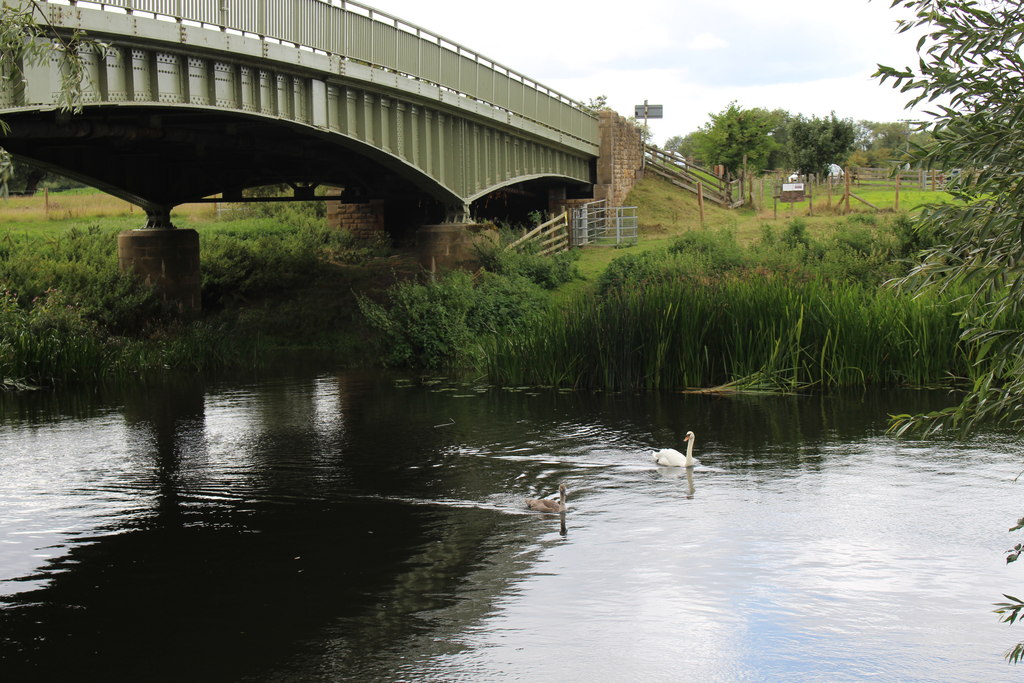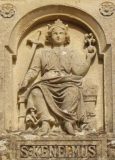Contents
St Kenelm’s Church, Clent
The walk starts here, close to the Clent Hill at the Small Church of St Kenelm, which once served the now lost village of Kenelmstow. Much of the building is Twelfth Century, including the Nave and chancel. There is an impressive tympanum over the doorway of Christ in Glory in a Romanesque form. A crude figure of St Kenelm adorns the outer South wall, Inside, there used to be a 14th century cycle of wall-painting depicting the legend of St Kenelm, but these were destroyed in a 1846 restoration. The Legend is depicted in the North window which was given in memory of the child victims of the First World War.
For more detail about this church, see the pages on the Churches of St Kenelm and Images of St Kenelm.

My parents are buried in this churchyard; I would like to take this opportunity to dedicate this site to their memory. If you should visit the church and happen to see this grave, please pause a moment.
Thank you.

St Kenelm’s Well, Clent
To the East of the church is the hollow in which the well is located. This is where the body of the Saint was supposed to have been discovered. Nearby Penorchard Farm has been suggested to be the site of the hunting lodge where Kenelm was staying at the time of his fatal hunting trip.
The continuing interest in traditional beliefs about holy wells is evidenced by the frequent presence of ribbons on a tree near to the well-head. Much more detail about the well is to be found by following the links below the picture.

- Discussion of St Kenelm’s Well, Clent.
- Further discussion of St Kenelm’s Well, Clent.
- Close study of the site of the Clent well
- Photos of St Kenelm’s Church and Well by Martin Jones
The Clent Hills
The largest of the Clent Hills is Walton Hill (which both the walks climb) which is 1,037 feet (316 m), followed by Clent Hill at 1,014 feet (309 m). They are separated by a valley known as St. Kenelm’s Pass. Alongside each of these two hills is a smaller hill; beside Clent Hill is Wychbury Hill and beside Walton Hill is Calcot Hill.
The north Worcestershire range of hills continues eastwards to include Romsley Hill, Waseley Hills and the Lickey Hills, all of which feature in the St Kenelm’s Trail, though not the St Kenelm’s Way.

Walton Hill has views over the Malvern Hills, Kinver Edge, The Wrekin, Wenlock Edge, Shatterford Hill, Clee Hills and back round to Kidderminster, Stourbridge, Dudley, Halesowen and Turner’s Hill. On a clear day observers can see as far as the Black Mountains of Wales, the northern Cotswolds, the southern Peak District and Charnwood Forest.
Huddington Court
The paths both go close to Huddington Court, an early Sixteenth Century timber framed house and one of the most picturesque imaginable. It was originally owned by the recusant Wintours family, two members of which were executed for participation in the Gunpowder Plot. Interestingly for the purposes of this site, another plotter, Sir Everard Digby, named his son Kenelm, presumably after the saint. Sir Kenelm Digby was to become a famous adventurer and writer in the Seventeenth Century.
The Gunpowder Plot, which was conceived by fanatics and stood no meaningful chance of achieving its aim of bringing about Spanish intervention in English affairs, was the final death-knell of Catholic England. Huddington Court is therefore an important landmark on the St Kenelm’s Way as it provides a link to the processes which resulted in the ending of the cult of the Saints and the disappearance of figures such as Kenelm from the popular imagination.
The house, which is in private ownership, contains an impressive priest hole on the second floor, and is reputed to be haunted by ghosts connected with the Gunpowder Plot. The Norman Church of St James stands in the grounds of the Court.

St Kenelm’s Church, Upton Snodsbury
Nearly all the present day church of St Kenelm dates from the late nineteenth century, although there is south-side fourteenth century window as well as a late perpendicular doorway. Brief church guides record the legend that St Kenelm’s body rested here on its final journey, and suggests that a wooden church was present in those days on the site of the present structure. A medieval preaching cross stands in the churchyard.

Jubilee Bridge
This bridge was erected in 1865 to mark the silver jubilee of Queen Victoria. The chronicles of St Kenelm record a dispute concerning ownership of the body of St Kenelm at an Avon crossing called Pyriford, a name now lost. Although some authorities suggest that the site must be a known ford near Pershore, it seems more likely that it was close to this place, as the Salt Way was known to cross the river between the villages of Fladbury and Cropthorne.

Hailes Abbey
Founded in 1246 and once a celebrated pilgrimage site, due to a phial possessed by the monks said to contain the blood of Christ, this Cistercian abbey now lies in ruins. Remains of the dramatic cloister arches survive and there is a small museum. The atmosphere of this abbey recalls some elegiac lines by Jacobean playwright John Webster, from his most famous play, The Duchess of Malfi:
I do love these ancient ruins We never set foot upon them but we set Our foot upon some reverend history. And questionless, here in this open court, Which now lies naked to the injuries Of stormy weather, some men lie interr’d Lov’d the church so well, and gave largely to ‘t They thought it should have canopy’d their bones Till doomsday (5.3.9-17)

St Kenelm’s Well, Winchcombe
This fascinating little monument is in fact a water-pump house which supplied the village of Winchcombe up to 1928 and was formerly attached to St Kenelm’s Chapel, a church built in the Sixteenth Century and demolished in 1830. The only surviving fragment of the chapel appears to be a blocked three light perpendicular windows at the rear of a nearby cottage dated 1838. The pump house was rebuilt in 1887 by J.D. Wyatt when the statue of the Saint was added over the door and dated AD 819, commemorating the martyrdom.


Sudeley Castle
This fine building, just outside Winchcombe, is more a palace than a castle and has something of a double history. The building mostly dates from the fifteenth century when it was owned by the Duke of Gloucester, later Richard III. In 1547 it passed to Lord Admiral Thomas Seymor who that year married Henry VIII’s widow Catherine Parr. The castle passed to the Seymor family in 1554 in whose ownership it remained until is was taken by rebels in the Civil War, at the end of which it was rendered uninhabitable.
The second phase of the Castle’s history began in 1837 when it was sold to the businessmen John and William Dent who set about a major restoration programme, bringing the house towards the condition we find today.
The chapel of St Mary’s in the grounds dates from 1460 and includes the tomb of Catherine Parr, enclosed in a Victorian monument. There is also a stained-glass window depicting St Kenelm.

St Peter’s Church, Winchcombe
Winchcombe was one of the most important of the Saxon towns of central England. By the early eighth century it was one of the main royal centres of the Kings of the Hwicce sub-kingdom who owed their allegiance to the Kings of Mercia. The Coventry Building Society Branch is suggested to mark the site of the Royal Palace where Kenelm would have lived. An Abbey was established in the late Eighth Century which achieved fame as the guardians of the body of St Kenelm and which lent the town great significance, but was to decline with the dissolution. This Benedictine Abbey, known as St Mary and St Kenelm from 969, has disappeared more completely than almost any other of comparable stature, but the Fifteenth Century Parish Church of St Peter’s, famous for its gargoyles, remains. Link

St Peter’s Church, Winchcombe

This painting, by Martin Podd, shows the abbey, next to St Peter’s Church, as it would probably have looked at the end of the 15th Century.
In the nineteenth century workmen who were engaged in excavating the foundations of the ruined monastery discovered a small stone coffin, beside a larger one, which lay immediately under the great eastern window of the church. They raised the lid and found within a little dust, a few fragments of the more solid bones, a half-grown human skull, and a long-bladed knife, converted into a brittle oxide, which fell in pieces in the attempt to remove it. These two stone coffins, believed to be those of Kenwulph and Kenelm, are now to be found in St Peter’s.

The land on which the Abbey formerly stood is now in private ownership and inaccessible. From the churchyard, however, may be seen a stone cross in the lawn in front of the adjacent property. This was erected in the nineteenth century to mark the centre of the tower of the former monastery. This view of the cross, which features an inscription recording the legend of St Kenelm, is a glimpsed memorial to a lost world, a symbolically fitting end to our journey.


